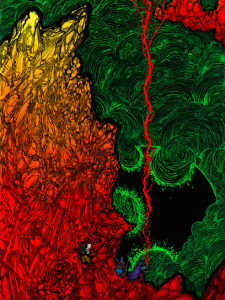Disclaimer: Lost Pages, the publisher of Into the Odd, also publishes my book Wonder & Wickedness.
Chris McDowall‘s Into the Odd started out as a game in what I would consider the 0E tradition, but it has evolved into something more distinct, both in setting and rules. The setting is the early modern fantastic. It recalls to me the mystic retro vibe of Full Metal Alchemist, but less manga and more Lewis & Clark.
The game itself is pared down to the absolute minimum of rules. This is closer to Searchers of the Unknown than it is to B/X. Character ability scores are strength, dexterity, and willpower, still 3d6 each. Basically, the 3E save categories reworked as abilities. Ability checks (called saves) are only reactive, rolled to avoid danger “from a risky action or situation.” There are no classes and magic powers mostly come from from arcana, a general catchall term for magic items. Determination of starting equipment is rolled into ability scores such that low stats tend to come along with a psychic power or arcanum.
My favorite innovation from Into the Odd is the leveling system. Accomplishing certain diegetic goals, in the manner of Xbox achievements, rather than XP thresholds, results in gaining levels. For example, to reach second level (“Professional”), a character must only survive one expedition. There are only five levels. When you unpack the mechanics and terminology, the underlying character details are not so different from D&D advancement (+1d6 HP per level and so forth), but the shift from “high score” (XP) progression to achievements is psychologically powerful. It would be a fun experiment to play B/X using this approach, perhaps extending the achievements up to tenth level and including objectives oriented around establishing a stronghold.
Sixty arcana are included, divided into three tiers of rarity or power, standard, greater, and legendary, 20 of each. Unfortunately, only the standard arcana are numbered, making it slightly less convenient to determine greater or legendary randomly, but one can always count down the page so that’s really a just me quibbling. Most could easily be adapted to other fantasy games and I appreciate how concisely and evocatively they are written. For one example, from page 11. Book of Despair: Summon a 20ft area of tentacles that lash out and grab. Anyone within must pass a str save to break free. The mass of tentacles has 10 hp and is destroyed at 0 hp.
In addition to the modular aspects noted above, there are a number of interesting design decisions in the game itself considered whole. For example, there is no attack roll, just a damage roll. This may seem odd to D&D-accustomed eyes, but mathematically the traditional attack roll followed by damage sequence can be collapsed into a single expected damage value (with the possibility set including outcomes of zero), and just rolling damage is not so different from an abstract, high level view, especially with ablative armor (which introduces the possibility of inflicting zero damage).
Overall, the book has 2 pages of character creation, 2 pages of rules, 1 page of guidelines for running organizations (which could probably benefit from expansion), 3 pages of 60 arcana, 3 pages of play example, 2 pages of referee advice, 1 page of example monsters, 1 page of advice on treasure, 1 page of trap rules, 1 page of setting background, 8 pages that contain two adventures (one dungeon and one hex crawl), 2 pages detailing a town, and the Oddpendium (14 pages of random tables including things like insane council decisions and weird creature inspiration). Definitely worth a look for anyone interested in rules-light approaches to fantasy games focusing on exploration.
Buy Into the Odd at the Lost Pages store. Note that come 2015, it may be unavailable for some period of time due to EU regulations.

